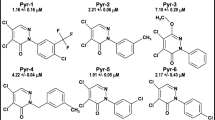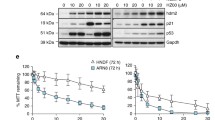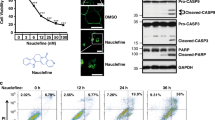Abstract
The aim of this study was to identify valproic acid (VPA) analogs with a broad spectrum of anti-cancer activities and an increased apoptosis-inducing potential compared with the parent VPA, which is enrolled as histone deacetylase (HDAC) inhibitor in a large number of clinical trials. We identified a chiral VPA derivative, (S)-2-pentyl-4-pentynoic acid, previously characterized as HDAC inhibitor that induced massive programmed cell death in a strongly enantioselective manner in U937 histiocytic lymphoma cells and NB4 acute promyelocytic leukemia cells. By performing fluorescence-activated cell sorting and Western blotting analyses, we established that enantiomer (S)-2-pentyl-4-pentynoic acid has higher apoptosis-inducing potential than VPA itself. The optic antipode (R)-2-pentyl-4-pentynoic acid and VPA caused under the same conditions only a weak growth inhibition without inducing cell differentiation and apoptosis. (S)-2-pentyl-4-pentynoic acid is more apoptogenic than VPA and displays enantioselective anti-cancer properties that warrant further research regarding the mechanistic basis of its activity and its potential use in cancer therapy.






Similar content being viewed by others
References
Ablain J, de The H (2011) Revisiting the differentiation paradigm in acute promyelocytic leukemia. Blood 117:5795–5802
Bojic U, Ehlers K, Ellerbeck U, Bacon CL, O’Driscoll E, O’Connel C, Berezin V, Kawa A, Lepekhin E, Bock E, Regan CM, Nau H (1998) Studies on the teratogen pharmacophore of valproic acid analogues: evidence of interactions at a hydrophobic centre. Eur J Pharmacol 354:289–299
Cinatl J Jr, Cinatl J, Driever PH, Kochetkov R, Pouckova P, Kornhuber B, Schwabe D (1997) Sodium valproate inhibits in vivo growth of human neuroblastoma cells. Anticancer Drugs 8:958–963
Clarkson A, Choonara I (2002) Surveillance for fatal suspected adverse drug reactions in the UK. Arch Dis Child 87:462–466
Cloyd JC, Dutta S, Cao G, Walch JK, Collins SD, Granneman GR (2003) Valproate unbound fraction and distribution volume following rapid infusions in patients with epilepsy. Epilepsy Res 53:19–27
Corsetti MT, Salvi F, Perticone S, Baraldi A, De Paoli L, Gatto S, Pietrasanta D, Pini M, Primon V, Zallio F, Tonso A, Alvaro MG, Ciravegna G, Levis A (2011) Hematologic improvement and response in elderly AML/RAEB patients treated with valproic acid and low-dose Ara-C. Leuk Res 35:991–997
Deubzer H, Busche B, Rönndahl G, Eikel D, Michaelis M, Cinatl J, Schulze S, Nau H, Witt O (2006) Novel valproic acid derivatives with potent differentiation-inducing activity in myeloid leukemia cells. Leuk Res 30:1167–1175
Duvic M, Zhang C (2006) Clinical and laboratory experience of Vorinostat (suberoylanilide hydroxamic acid) in the treatment of cutaneous T-cell lymphoma. Brit J Cancer 95:S13–S19
Eikel D, Hoffmann K, Zoll K, Lampen A, Nau H (2006a) S-2-Pentyl-4-pentynoic hydroxamic acid and its metabolite S-2-pentyl-4-pentynoic acid in the NMRI-exencephaly-mouse model: pharmacokinetic profiles, teratogenic effects, and histone deacetylase inhibition abilities of further valproic acid hydroxamates and amides. Drug Metab Disp 34:612–620
Eikel D, Lampen A, Nau H (2006b) Teratogenic effects mediated by inhibition of histone deacetylases: evidence from quantitative structure activity relationships of 20 valproic acid derivatives. Chem Res Toxicol 19:272–278
Foley AG, Gallagher HC, Murphy KJ, Regan CM (2004) Pentyl-4-yn-valproic acid reverses age-associated memory impairment in the Wistar rat. Neurobiol Aging 25:539–546
Gore SD, Jones C, Kirkpatrick P (2006) Decitabine. Nat Rev Drug Discov 5:891–892
Gotfryd K, Skladchikova G, Lepekhin EA, Berezin V, Bock E, Walmod PS (2010) Cell type-specific anti-cancer properties of valproic acid: independent effects on HDAC activity and Erk1/2 phosphorylation. BMC Cancer 10:383–395
Gotfryd K, Hansen M, Kawa A, Ellerbeck U, Nau H, Berezin V, Bock E, Walmod PS (2011) The teratogenic potencies of valproic acid derivatives and their effects on biological end-points are related to changes in histone deacetylase and Erk1/2 activities. Basic Clin Pharmacol Toxicol 109:164–174
Göttlicher M, Minucci S, Zhu P, Krämmer OH, Schimpf A, Giavara S, Sleeman JP, Lo Coco F, Nervi C, Pelicci PG, Heinzel T (2001) Valproic acid defines a novel class of HDAC inhibitors inducing differentiation of transformed cells. EMBO J 20:6969–6978
Grant S, Easley C, Kirkpatrick P (2007) Vorinostat. Nat Rev Drug Discov 6:21–22
Gravemann U, Volland J, Nau H (2008) Hydroxamic acid and fluorinated derivatives of valproic acid: anticonvulsant activity, neurotoxicity and teratogenicity. Neurotoxicol Teratol 30:390–394
Gurvich N, Tsygankova OM, Meinkoth JL, Klein PS (2004) Histone deacetylase is a target of valproic acid-mediated cellular differentiation. Cancer Res 64:1079–1086
Insinga A, Monestiroli S, Ronzoni S, Gelmetti V, Marchesi F, Viale A, Altucci L, Nervi C, Minucci S, Pelicci PG (2005) Inhibitors of histone deacetylases induce tumor-selective apoptosis through activation of the death receptor pathway. Nat Med 11:71–76
Issa JP, Kantarjian HM, Kirkpatrick P (2005) Azacitidine. Nat Rev Drug Discov 4:275–276
Keedwell RG, Zhao Y, Hammond LA, Qin S, Tsang K-Y, Reitmair A, Molina Y, Okawa Y, Atangan LI, Shurland DL, Wen K, Wallace DM, Bird R, Chandraratna RA, Brown G (2004) A retinoid-related molecule that does not bind to classical retinoid receptors potentially induces apoptosis in human prostate cancer cells through rapid caspase activation. Cancer Res 64:3302–3312
Knupfer MM, Hernaiz-Driever P, Poppenborg H, Wolff JE, Cinatl J (1998) Valproic acid inhibits proliferation and changes expression of CD44 and CD56 of malignant glioma cells in vitro. Anticancer Res 18:3585–3589
Kuendgen A, Gattermann N (2007) Valproic acid for the treatment of myeloid malignancies. Cancer 110:943–954
Kuendgen A, Knipp S, Fox F, Strupp C, Hildebrandt B, Steidl C, Germing U, Haas R, Gattermann N (2005) Results of a phase 2 study of valproic acid alone or in combination with all-trans retinoic acid in 75 patients with myelodysplastic syndrome and relapsed or refractory acute myeloid leukemia. Ann Hematol 84:61–66
Melnick A, Licht JD (1999) Deconstructing a disease: RARα, its fusion partners, and their roles in the pathogenesis of acute promyelocytic leukemia. Blood 93:3167–3215
Minucci S, Pelicci PG (2006) Histone deacetylase inhibitors and the promise of epigenetic (and more) treatments for cancer. Nat Rev Cancer 6:38–51
Mongan NP, Gudas LJ (2005) Valproic acid, in combination with all-trans retinoic acid and 5-aza-2′-deoxycytidine, restores expression of silenced RARα2 in breast cancer cells. Mol Cancer Ther 4:477–486
Murphy KJ, Fox GB, Foley AG, Gallagher HC, O’Connel A, Griffin A-M, Nau H, Regan CM (2001) Pentyl-4-yn-valproic acid enhances both spatial and avoidance learning, and attenuates age-related NCAM-mediated neuroplastic decline within the rat medial temporal lobe. J Neurochem 78:704–714
Nau H, Rating D, Koch S, Hauser I, Helge H (1981) Valproic acid and its metabolites: placental transfer, neonatal pharmacokinetics, transfer via mother’s milk and clinical status of neonates of epileptic mothers. J Pharmacol Exp Ther 219:768–777
Nebbioso A, Clarke N, Voltz E, Germain E, Ambrosino C, Bontempo P, Alvarez R, Schiavone EM, Ferrara F, Bresciani F, Weisz A, de Lera AR, Gronemeyer H, Altucci L (2005) Tumor-selective action of HDAC inhibitors involves TRAIL induction in acute myeloid leukemia cells. Nat Med 11:77–84
Nebbioso A, Pereira R, Khanwalkar H, Matarese F, Garcia-Rodriguez J, Miceli M, Logie C, Kedinger V, Ferrara F, Stunnenberg HG, de Lera AR, Gronemeyer H, Altucci L (2011) Death receptor pathway activation and increase of ROS production by the triple epigenetic inhibitor UVI5008. Mol Cancer Ther 10:2394–2404
Raffoux E, Cras A, Recher C, Boëlle PY, de Labarthe A, Turlure P, Marolleau JP, Reman O, Gardin C, Victor M, Maury S, Rousselot P, Malfuson JV, Maarek O, Daniel MT, Fenaux P, Degos L, Chomienne C, Chevret S, Dombret H (2010) Phase 2 clinical trial of 5-azacitidine, valproic acid, and all-trans retinoic acid in patients with high-risk acute myeloid leukemia or myelodysplastic syndrome. Oncotarget 1:34–42
Soprano DR, Qin P, Soprano KJ (2004) Retinoic acid receptors and cancers. Annu Rev Nutr 24:201–221
Soriano AO, Yang H, Faderl S, Estrov Z, Giles F, Ravandi F, Cortes J, Wierda WG, Ouzounian S, Quezada A, Pierce S, Estey EH, Issa JP, Kantarjian HM, Garcia-Manero G (2007) Safety and clinical activity of the combination of 5-azacytidine, valproic acid, and all-trans retinoic acid in acute myeloid leukemia and myelodysplastic syndrome. Blood 110:2302–2308
Acknowledgments
This work was supported by European grant NUTRICEPTORS HPRN-CT-2002-00268. Work in the laboratory of HG was supported by the European community (contracts HEALTH-F4-2007-200767 `APO-SYS', LSHC-CT-2005-518417 `EPITRON' and HEALTH-F4-2009-221952 `ATLAS'), the Institut National du Cancer (INCa), the Fondation ARC and the Ligue National contre le Cancer (laboratoire labellisé). The authors thank Dr. Claudine Gaudon, Audrey Bindler-Furst and Michele Lieb for excellent technical assistance.
Conflict of interest
The authors declare no conflict of interest.
Author information
Authors and Affiliations
Corresponding authors
Rights and permissions
About this article
Cite this article
Ivanova, D., Gronemeyer, H., Steinberg, P. et al. Enantioselective apoptosis induction in histiocytic lymphoma cells and acute promyelocytic leukemia cells. Arch Toxicol 87, 303–310 (2013). https://doi.org/10.1007/s00204-012-0930-3
Received:
Accepted:
Published:
Issue Date:
DOI: https://doi.org/10.1007/s00204-012-0930-3




